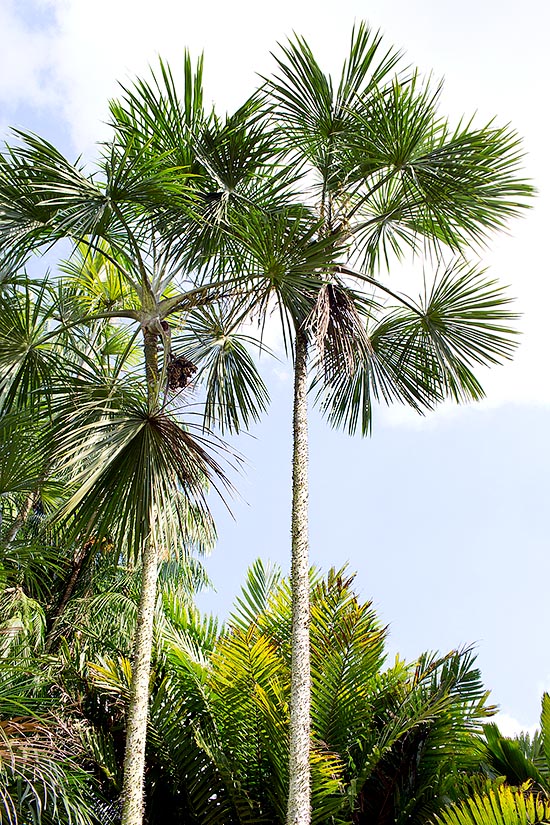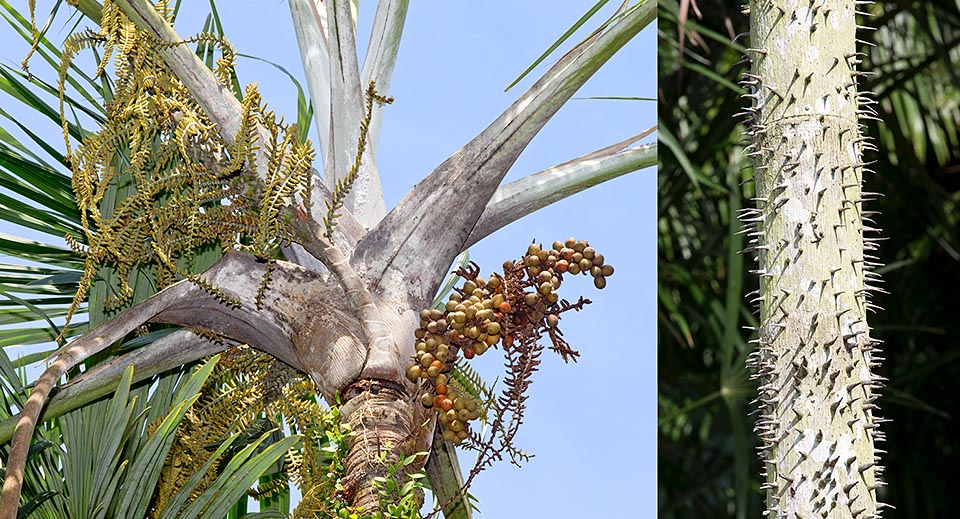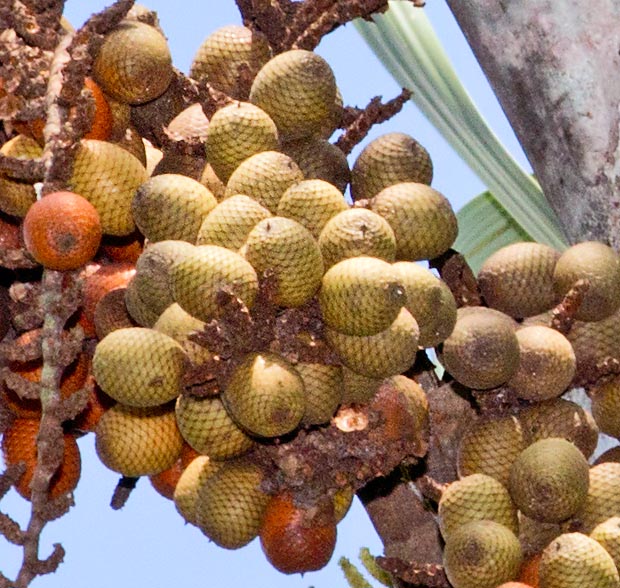Family : Arecaceae

Text © Pietro Puccio

English translation by Mario Beltramini

Mauritiella armata can be 20 m tall with 8-14 cm trunks © Giuseppe Mazza
The name of the genus is the diminutive of Mauritia, due to the resemblance, in smaller version, with this genus; the name of the species is the Latin adjective “armatus, a, um” = armed, with reference to the spines on the stem.
Common names: multistemmed buriti palm (English); buriticillo (Bolivia); caraná, caranã, caraná-de-espinhos, buritirana, buriti-bravo buriti-mirim, buritizeiro-bravo, buritizinho, inajá, xiriri (Brazil); cananguchillo (Colombia); moretillo (Ecuador); aguajillo, cahuaia (Peru); morichito, uliya (Venezuela).
The Mauritiella armata (Mart.) Burret (1935) is a cespitous dioecious species, rarely solitary, with slender erect whitish stems, 5-20 m tall and of 8-14 cm of diameter, on which are visible the rings trace of the fallen leaves spaced of about 10 cm, armed at least in the lower part of conical spiny adventitious roots, 1-3 cm long, which take root close to the base forming a mass of roots.
The leaves are slightly costapalmate, reduplicate, almost circular, 1-1,4 m broad, of glossy dark green colour above, covered by white-bluish pruinescence below, deeply subdivided almost up to the base in 30-80 linear-lanceolate segments, long, in the median part 0,6-1,2 m and 1,5-3,5 cm broad, with drooping pointed apex; the petioles are 60-80 cm long, unarmed, oval in section, covered by whitish pruinescence.
The male and female inflorescences, on different individuals, are similar, coming out between the leaves (interfoliar) with ramifications of second order, up to about 1 m long, initially erect, and then drooping. The fruits are globose to ovoid, 2,5-3,5 cm long and of 2-3 cm of diameter, with epicarp covered by rhomboid brown reddish scales arranged vertically, containing only one ellipsoidal white seed. It reproduces by seed, previously kept in water for two days, in loam maintained humid at the temperature of 26-28 °C, with germination times varying from some months to one year.

Female plant with two inflorescences and one fructescence. Right, detail of trunk with spiny conical adventitious roots © Giuseppe Mazza

From the fruits they get a drink with addition of sugar or cassava © Giuseppe Mazza
From the fruits oily sour pulp they get a drink with addition of sugar or of manioc flour (cassava).
The segments of the leaves are utilized for making baskets and other handicrafts.
Synonyms: Mauritia aculeata Mart. (1824); Mauritia armata Mart. (1824); Mauritia martiana Spruce (1869); Lepidococcus armatus (Mart.) H.Wendl. & Drude (1878); Oenocarpus dealbatus H.Wendl. (1878); Mauritia peruviana Becc. (1918); Mauritia huebneri Burret (1929); Mauritia intermedia Burret (1929); Mauritiella duckei Burret (1935); Mauritiella huebneri (Burret) Burret (1935); Mauritiella intermedia (Burret) Burret (1935); Mauritiella martiana (Spruce) Burret (1935); Mauritiella peruviana (Becc.) Burret (1935); Mauritiella campylostachys Burret (1942); Mauritiella macrospadix Burret (1942); Mauritiella nannostachys Bur- ret (1942); Lepidococcus duckei (Burret) A.D.Hawkes (1952); Lepidococcus huebneri (Burret) A.D.Hawkes (1952); Lepidococcus intermedius (Burret) A.D.Hawkes (1952); Lepidococcus martianus (Spruce) A.D.Hawkes (1952); Lepidococcus peruvianus (Becc.) A.D.Hawkes (1952); Lepidococcus pumilus (Wallace) H. Wendl. & Drude ex A.D. Hawkes (1952); Mauritia campylostachys (Burret) Balick (1981); Mauritia duckei (Burret) Balick (1981); Mauritia macrospadix (Burret) Balick (1981); Mauritia nannostachys (Burret) Balick (1981).
→ For general notions about ARECACEAE please click here.
